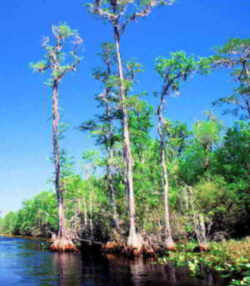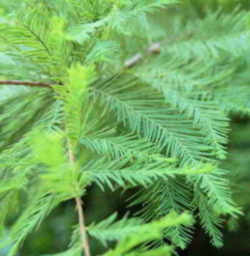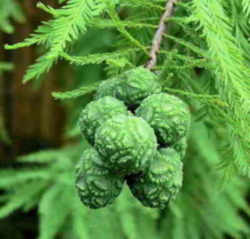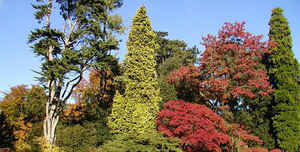
Louisiana Symbols
Louisiana State Tree
Bald Cypress

(Taxodiaceae Taxodium distichum)
Adopted on May 26, 1963.
In the early 1960s, fourth graders from Jefferson Terrace Elementary School in Baton Rouge, with their teacher Mrs. Juanita Sommers petitioned Louisiana legislators to add the cypress to Louisiana's list of official symbols and emblems.
By legislative Act No. 49, the bald cypress was made the official state tree of the state of Louisiana on May 26, 1963.
Act No. 49 identifies the official tree as "bald cypress" (Taxodium distichum,) offering that the bald cypress
is commonly known as the 'cypress" tree. Today, the tree is often referred to as the bald cypress.
Louisiana State Tree: Bald Cypress

Taxodium distichum (bald cypress, baldcypress, bald-cypress, cypress, southern-cypress, white-cypress, tidewater red-cypress, Gulf-cypress, red-cypress, or swamp cypress) is a deciduous conifer that grows on saturated and seasonally inundated soils of the Southeastern and Gulf Coastal Plains of the United States.
Half of Louisiana is timbered with an abundance of varied and beautiful trees, but no action was taken to designate a state tree until 1963 when the bald cypress, Taxodiaceae Taxodium distichum, was made the official tree of Louisiana. The cypress grows in many areas of the state, particularly the swampy areas.
Its shape depends greatly on the amount and duration of flooding in the area, and varies from columnar to conical or bottle shaped. The bark is reddish-brown, fibrous, thin, and divided into small, flat ridges and shallow furrows. Leaves of the cypress tree spread in flat planes in a feathery pattern on its branchlets.
Bald cypress is a deciduous conifer that grows on saturated and seasonally inundated soils of the Southeastern and Gulf Coastal Plains. Two varieties share essentially the same natural range. Variety nutans, commonly called pond cypress, cypress, or black-cypress, grows in shallow ponds and wet areas westward only to southeastern Louisiana. It does not usually grow in river or stream swamps. Variety distichum, commonly called bald cypress, cypress, southern -cypress, swamp-cypress, red-cypress, yellow-cypress, white-cypress, tidewater red-cypress, or gulf-cypress, is more widespread and typical of the species. Its range extends westward into Texas and northward into Illinois and Indiana.

Pond cypress is less likely than bald cypress to have knees, and its knees are shorter and more rounded. Its fluted base tends to have rounded rather than sharp ridges and its bark usually is more coarsely ridged .Its branchlets are more ascending than those of bald cypress , but unfortunately it was given the varietal name nutans (nodding) from observation of a cultivated variation having drooping branches. Typical specimens of pond cypress have nearly scale like leaves, which are appressed along the twig in several ranks. Seedlings and fast-growing shoots of pond cypress, however, often have disichous (two-ranked) leaves much like typical bald cypress foliage. Despite the usual differences in appearance between the two varieties, not all specimens are typical, and it is often difficult and sometimes impossible to distinguish them .
Identification of the Bald Cypress
Leaf: Linear and small, 1/4 to 3/4 inch long, green to yellow-green, generally appearing two-ranked. When growing on deciduous branchlets the leaf-deciduous branchlet structure resembles a feathery pinnately (or bi-pinnately) compound leaf.
Flower: Males in drooping long panicles. Females are subglobose, peltate scales, and tend to occur near the end of branches.
Fruit: Cones are composed of peltate scales forming a woody, brown sphere with rough surfaces, 3/4 to 1 inch in diameter. Cones disintegrate into irregular-shaped seeds.
Twig: May be deciduous or not. Non-deciduous twigs are slender, alternate, brown, rough, with round buds near the end of the twig. Deciduous twigs are two-ranked, resembling pinnately compound leaves.
Bark: Fibrous, red-brown but may be gray where exposed to the weather. Old, thick bark may appear somewhat scaly.
Louisiana Laws
The law designating the baldcypress as the official Louisiana state tree is found in the Louisiana Statutes, Title 49 (State administration), Section RS 49:160.
TITLE 49 - State administration
RS 49:160 - State tree
Universal Citation: LA Rev Stat § 49:160
§160. State tree
The baldcypress (Taxodium distichum), commonly known as the "cypress" tree, is hereby designated and hereafter shall be known as the official
state tree of the state of Louisiana.
Acts 1963, No. 49.
Taxonomic Hierarchy: Bald Cypress
Kingdom: Plantae - Plants
Subkingdom: Tracheobionta - Vascular plants
Superdivision: Spermatophyta - Seed plants
Division: Coniferophyta - Conifers
Class: Pinopsida
Order: Pinales
Family: Cupressaceae - Cypress family
Genus: Taxodium Rich. - bald cypress
Species: Taxodium distichum (L.) Rich. - bald cypress







